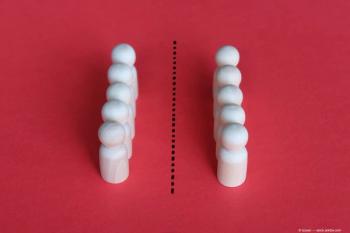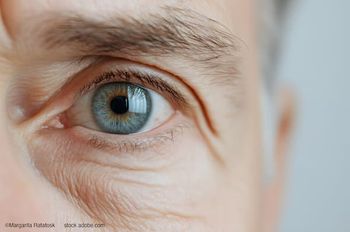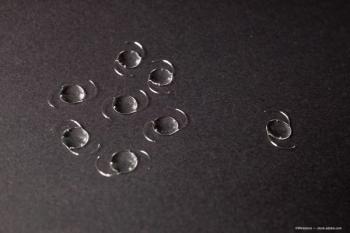
- Vol. 44 No. 17
- Volume 44
- Issue 17
Dealing with positive and negative dysphotopsias
Don’t discount dysphotopsias, either positive or negative, after cataract surgery and IOL placement. The literature suggests that dysphotopsias are relatively rare, but patient reports suggest a different story.
Don’t discount dysphotopsias, either positive or negative, after
“If you ask patients, it can be almost 50% immediately after surgery,” said
Dr. Mamalis discussed the etiology and treatment of positive and negative dysphotopsias during the
Both positive and negative dysphotopsias are associated with the IOL material, design and placement, he continued.
RELATED:
Positive dysphotopsias are most often characterized by persistent bright rings, flares, arcs, halos, and flashes that most often appear when light is coming into
the eye from the side, such as the oncoming headlights of another vehicle. The long term incidence may be as high as 1.5% and can vary greatly by IOL type, material, and design.
Positive dysphotopsia was first reported in polymethylmethacrylate (PMMA), the material most commonly used during the early development of IOLs. Symptoms were generally minor glare and transient.
Hydrophobic acrylic lenses are more prone to positive dysphotopsia. The higher index of refraction is more likely to result in internal reflections when exposed to bright sources.
Silicone lenses are rarely associated with positive dysphotopsia, possibly because of lens design. Lenses with square edges, typically hydrophobic acrylic IOLs, are associated with an increased incidence of positive dysphotopsia. Frosted and textured edges as well as beveled designs have been used to reduce the intensity of stray reflections and reduce the incidence of positive dysphotopsia.
RELATED:
Treating positive dysphotopsias is relatively straightforward. Explanting and exchanging the original lens with an IOL that has a different material or edge
design usually reduces or removes the problem entirely. PMMA, silicone, and hydrophilic acrylic lenses with edge designs that are not square are reported to help resolve positive dysphotopsias.
“Negative dysphotopsias are completely different,” Dr. Mamalis said. “The more often you ask about negative dysphotopsias, the more frequently patients report those dark temporal shadows, especially in the first couple of weeks.”
About 71% of negative dysphotopsias resolve in the first weeks and months after surgery, he continued. Depending on how and when patients are questioned, between 0.2% and 2.4% have persistent symptoms.
“Don’t get too excited at first and try to do something about it immediately,” he advised. “In a lot of patients, it goes away.”
RELATED:
The etiology of negative dysphotopsias involves the spatial relationships between the IOL, the capsular bag, and possibly the iris. IOLs implanted in the capsular bag or in the posterior chamber are more likely to produce negative dysphotopsias while IOLs implanted in the sulcus or in the anterior chamber seldom do.
Ray tracing suggests that at least part of the problem lies with internal reflections when the lens is placed in the capsular bag that can cast temporal shadows. Other potential factors include corneal curvature, anterior chamber depth, IOL power, axial length and the distance between the pupil and the implant.
“Negative dysphotopsias are seen more frequently in patients who have a square edge IOL,” Dr. Mamalis said. “It can occur with any lens material, though we see it more frequently with hydrophobic acrylic.”
Treatment typically involves IOL exchange and implantation of a new lens into the sulcus. Piggyback, or add-on, IOLs can also help alleviate negative dysphotopsias by diffusing light more effectively before it enters the eye, reducing the potential for shadow formation.
Reverse optic capture, placing the optic over the edges of the capsular bag instead of in the bag, can also help. And some surgeons perform laser anterior capsulotomy to enlarge the capsule opening.
RELATED:
New lens designs may reduce the problem in the future. The Masket lens, with a groove on the anterior surface, allows the lip of the optic to ride over the anterior capsule, reducing the potential for negative dysphotopsias. A bag-in-lens design serves the same purpose, putting the optic atop the bag rather than allow the bag to ride over the edge of the optic.
Another design adds peripheral concavity to the optic to better diffuse light entering the eye, reducing the potential for shadows.
“The treatment varies,” Dr. Mamalis said. “Depending on the patient, changes in IOL material, design and placement can decrease or treat these dysphotopsias when they occur.”
Disclosures:
Nick Mamalis, MD
Dr. Mamalis is professor of ophthalmology, John A. Moran Eye Center, University of Utah, Salt Lake City. He did not indicate any proprietary interest in the subject matter.
Articles in this issue
about 6 years ago
The ABCs of VEGF treatment for diabetic macular edemaabout 6 years ago
The future: Development of true accommodative IOLsNewsletter
Don’t miss out—get Ophthalmology Times updates on the latest clinical advancements and expert interviews, straight to your inbox.



















































.png)


